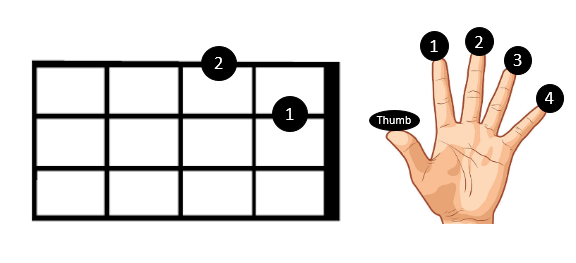
The A major chord on the ukulele is a simple and commonly used chord, especially in many popular songs. Below are some tips and a step-by-step guide on how to play the A major ukulele chord correctly.
Finger Position for A Major Ukulele Chord
-
Place your index finger on the 1st fret of the 3rd string (C string).
This is the only note you need to press down on the ukulele for the A major chord. -
Keep the other fingers relaxed and avoid pressing any other strings.
-
Strum all four strings starting from the 4th string (G string). Since the other strings (4th, 2nd, and 1st) are played open, there is no need to press them down.
Visualizing the A Major Chord on Ukulele
- String 4 (G string): Open (Do not press down).
- String 3 (C string): Pressed on the 1st fret (with your index finger).
- String 2 (E string): Open (Do not press down).
- String 1 (A string): Open (Do not press down).
Tips for Playing the A Major Ukulele Chord
-
Use the Tip of Your Index Finger:
When placing your index finger on the 1st fret of the C string, try to use the very tip of your finger. This will help you avoid muting or touching the adjacent strings unintentionally. -
Ensure Open Strings Ring Clearly:
Make sure that the strings you’re not pressing (G, E, and A) are ringing clearly when strummed. If they sound muted or muffled, check your finger positioning and ensure that none of your fingers are accidentally touching those strings. -
Relax Your Hand:
Keep your hand relaxed and avoid unnecessary tension in your fingers. Tension can affect the sound and make it harder to transition to other chords. -
Strum with Proper Technique:
When strumming the ukulele, aim to hit all four strings evenly. Strumming from the top (G string) to the bottom (A string) will produce the most natural sound. -
Practice Finger Transitions:
Since the A major chord is often used in common chord progressions (such as G-C-A), practice transitioning to and from the A major chord with other basic chords like C, G, and F to improve your speed and accuracy.
Common Mistakes to Avoid
- Muting Strings: Ensure you are not accidentally muting the G or E strings with your fingers. Keep your hand relaxed and your fingers arched.
- Incorrect Pressure: Don’t press too hard on the C string with your index finger. Press just enough to get a clean note. Too much pressure can cause buzzing.
Final Thoughts
The A major chord is simple to play, but with practice, you’ll be able to play it cleanly and quickly. Once you get comfortable with this chord, try incorporating it into your songs or practice chord progressions to strengthen your playing.
